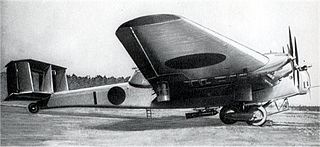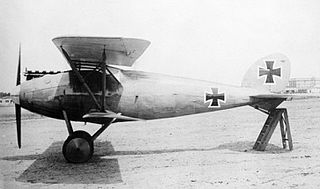Related Research Articles

The Hawker Harrier was an experimental biplane torpedo bomber aircraft built by Hawker Aircraft to a specification issued in the 1920s for the RAF.

The MB.210 and MB.211 were the successors of the French Bloch MB.200 bomber built by Societé des Avions Marcel Bloch in the 1930s and differed primarily in being low wing monoplanes rather than high wing monoplanes.

The Albatros C.III was a German two-seat general-purpose biplane of World War I, built by Albatros Flugzeugwerke. The C.III was a refined version of the successful Albatros C.I and was eventually produced in greater numbers than any other C-type Albatros.

The Mitsubishi Ki-20 is a Japanese bomber variant of the Junkers G.38 airliner. Mitsubishi manufactured six aircraft under license from Junkers. These aircraft, designated Army Type 92 Heavy Bomber, served through the 1930s. During World War II, the Ki-20 served in a variety of transport and support roles.

The Fokker D.I was a development of the D.II fighter. The D.I was also flown in Austro-Hungarian service as a fighter trainer aircraft under the designation B.III. Confusing the matter further, both the D.II and D.I arrived at the Front in German service at similar times, in July–August 1916. The main designer was Martin Kreutzer.

The Friedrichshafen G.II was a medium bomber aircraft that was designed and manufactured in Germany during World War I by Flugzeugbau Friedrichshafen. The plane was used by the Luftstreitkräfte for tactical and limited strategic bombing operations.

The LFG Roland C.II, usually known as the Walfisch (Whale), was an advanced German reconnaissance aircraft of World War I. It was manufactured by Luft-Fahrzeug-Gesellschaft G.m.b.H.

Entering service in 1915, the Rumpler C.I,, two-seater single-engine reconnaissance biplane, was one of the first German C-type aircraft, and also one of the longest serving in its class during World War I, being retired from the last front line units only in early 1918.

The Linke-Hofmann R.II was a bomber aircraft designed and built in Germany from 1917.

The Gotha WD.14, WD.20, and WD.22 were a family of biplane torpedo bomber floatplanes developed in Germany during World War I.
The Kondor D 7 was a prototype German single seat biplane fighter built over the winter of 1917-18. It was not a success and its development was soon abandoned.

The LFG Roland D.VII was a German single seat, single engine biplane fighter aircraft built during World War I. Problems with its underdeveloped V-8 engine prevented its production.

The Schütte-Lanz G.I was a large, twin engine, pusher configuration, experimental biplane built in Germany early in World War I. Only one was completed.
The Schütte-Lanz D.VII was a single engine, biplane fighter aircraft designed and built in Germany towards the end of World War I.

The Albatros C.XIII was a German two-seat, single-engine, biplane light fighter aircraft built in 1917. Only one was constructed.

The Albatros C.XIV was a German two seat, single engine, biplane fighter aircraft built in 1918. Only one was constructed.
The Albatros W.3, company designation VT was a twin engine, biplane, float plane torpedo bomber, delivered to the Imperial German Navy in 1916. Only one was built.

The Siemens-Schuckert L.I was a large, three-engined biplane bomber aircraft, built in Germany towards the end of World War I. It was a twin boom design, strongly influenced by the successful Caproni Ca.3. Three were built but not used operationally.
The Halberstadt G.I was a German prototype medium bomber built by Halberstädter Flugzeugwerke during World War I.
The DFW D.I was a German fighter aircraft produced during World War I.
References
- 1 2 3 4 Gray, Peter; Thetford, Owen (1970). German Aircraft of the First World War . London: Putnam. pp. 257. ISBN 0-85177-809-7.